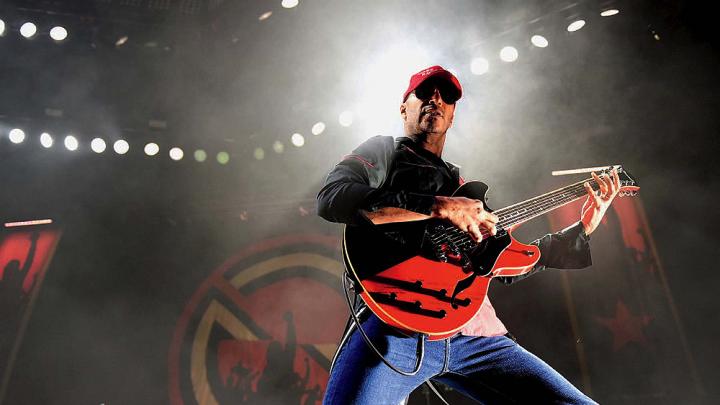Guitarist Tom Morello ’86 was watching CNN one day in 2016 when a peculiar headline caught his eye: “Donald Trump Rages Against the Machine.”
The chyron cheekily referenced Rage Against the Machine, the 1990s rock band whose pioneering synthesis of hip-hop’s rhythmic lyricism and heavy metal’s guitar-driven pyrotechnics Morello helped to define on Rage’s airwaves-incinerating first record in 1992. Morello was furious at the comparison drawn between the Republican candidate’s pledge to “drain the swamp” and Rage’s anti-authoritarian and socialist ideals. So, he says, “I did what any self-respecting pissed-off person would do: I wrote a snarky tweet about it.”
Then he called some friends—his former Rage bandmates Brad Wilk (drums) and Tim Commerford (bass), as well as emcees B-Real and Chuck D (the vocalists behind legendary hip-hop groups Cypress Hill and Public Enemy, respectively)—to propose a collaboration. Their previous projects were all expressly political; by performing those songs again, Morello hypothesized, perhaps they could alert audiences to the dangers they perceived in a possible Trump presidency. And so the all-star touring machine Prophets of Rage was born.
Morello doesn’t identify with the president’s particular brand of populism, but he does have a window into its appeal. He grew up in Libertyville, Illinois, a town near the Wisconsin border that he morosely describes as Trump Country. He remembers “feeling totally politically impotent in a small town where the options were trying out for the wrestling team or working at Dairy Queen—all while apartheid raged in South Africa and government death squads killed nuns in Central America.” Music was “a tether,” something that “made me feel like I wasn’t alone in my worldview or in my small town.” By the end of high school, Morello, then a self-described “Spandex-wearing metalhead,” had developed both a love for the guitar and what he describes as “a great revolutionary fervor” to raise awareness of distant social problems and arm people with both the desire and knowledge necessary to make change.
Balancing schoolwork and mastering an instrument posed “serious time-management challenges.” He often wondered if he was “wasting my time in the stacks of Widener Library when I should be spreading the message, playing barrooms across Ohio.”
At Harvard, this passion led him to concentrate in social studies—an honors program that he didn’t initially realize required significant academic effort. Balancing schoolwork and mastering an instrument posed “serious time-management challenges.” He often wondered if he was “wasting my time in the stacks of Widener Library when I should be spreading the message, playing barrooms across Ohio.”
Gradually, however, this contradiction began to appear more like a harmony. Music, Morello felt, was a natural vehicle for the political ideas he was honing in class. As he devoted long hours to the guitar—polishing his technique, gigging with cover bands, and beginning to write songs—academic work felt less like a distraction than “a way to arm myself intellectually.” Now, he chuckles at the memory of “practicing guitar for four hours a day in a stairwell, trying to read Max Weber at the same time.”
After graduating, Morello headed for Los Angeles, where he played in several bands and worked in the offices of U.S. senator Alan Cranston before forming Rage Against the Machine with Wilk, Commerford, and vocalist Zack de la Rocha in 1991. His adopted hometown has played a huge role in his work. Both Rage and Prophets are, by his account, “bands that could only happen in Los Angeles.…The music sounds like the city: there’s hip-hop, punk rock, hard rock—all of which are huge cultural components of Los Angeles’s music history. But you can also hear a class tension in the music, where you see Lamborghinis rolling by homeless encampments on Sunset Strip.”
Morello’s ability to channel that tension into his guitar work is a large part of what keeps Prophets of Rage from becoming, in his words, “a nostalgia act.” Prophets of Rage, the album of original material the band released last fall, sounds less like a truly new work than a synthesis of the members’ previous groups: Rage Against the Machine’s raw heavy-metal power; the contemplative melancholia of its successor, Audioslave (which Morello, Wilk, and Commerford formed in 2001 with Soundgarden singer Chris Cornell); Public Enemy’s machine-gun lyricism; Cypress Hill’s dark, slinky funk. The songs mix hip-hop’s grooving tempos and syncopated backbeats with the simple harmonies and overdriven crunch of heavy metal, with Chuck D and B-Real delivering plenty of timely political observations (reflecting on LA’s homelessness epidemic, B-Real raps, “Living on the 110, four sharing one tent / Can’t afford no rent, forgotten by the government”). But although the album features somewhat less of Morello’s signature FX-driven experimentalism, his guitar is its strongest aesthetic anchor. The rhythmic swagger of “Strength in Numbers”—a paean to working-class solidarity—and the slithering, metallic anti-nationalist anthem “Who Owns Who” keep easy pace with his fiery performances on older tracks like Rage’s “Vietnow” and Audioslave’s “Set it Off.”
The smile is almost audible in Morello’s voice as he happily reports that a large percentage of their audience is too young to have been original Rage fans; he is excited to be attracting and, he hopes, converting a new generation of listeners. But more broadly, he continues, he thinks of the album as addressed to…well, everyone. “I hope the album is a clarion call to those who know in their hearts that the world is not owned and run by people who deserve to be owning and running it—and that there is a better way, a different way, to achieve a more decent and humane planet. And if you take that to heart, you can be the David to any Goliath.”








